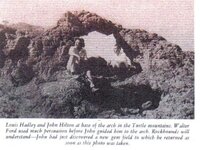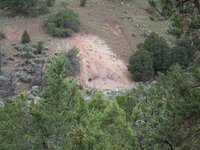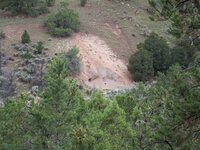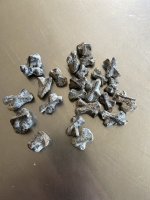Old Bookaroo
Silver Member
- Dec 4, 2008
- 4,318
- 3,510
“The Lost Arch” Diggings.
from The Miner’s Guide; A Ready Handbook for the Prospector and Miner, by Horace J. West (Los Angeles: Second Edition – 1925)
Somewhere in the northern portion of the Turtle Range of mountains, a range east and south of the range designated as the Old Woman’s Mountain on the Colorado River in California, lies the Lost Arch, twice located and twice lost by the peculiar workings of Providence.
Jim Fish and his partner, a prospector who arrived in the days of the first gold rush to California, were traveling from Nevada to California in the year 1883, in an old-fashioned buckboard behind a team of stringy bay horses. They had apparently filled their barrel of water at the Colorado and continued on their slow search for hidden wealth.
For months they had been prospecting through the little-known country, stopping here and there, climbing hills and following streams through unknown ranges. Occasionally they secured sufficient game to supply them with meat. Once or twice they met with friendly Indians and bartered for dry corn and beans which were grown on the high and almost inaccessible mesas of that part of the country.
And then came the event which startled them. They had traveled two days from the Colorado when Fish happened to investigate more closely the water-supply. He had turned the barrel up and found that little fluid was forthcoming. Almost frantically he pulled out the bung. He rolled the barrel around to the opening and carefully planted beneath it a bucket. Less than two canteen measures remained.
The situation was not entirely new to a veteran in the mountains, but he at once realized the dilemma that confronted him. He waited for his partner, whose name is said to have been Crocker, through this fact has never been established, and when he came in from his trip to the adjacent hills he imparted his bad news.
Some vegetation showed on the range near at hand and it was decided to risk a day in search for the precious fluid in the gulches and canyons of the mountains.
“It’s our best chance,” said Fish to Crocker after the two had talked over the matter for hours into the night.
So early in the morning, after four or rive hours of rest, they started resolutely to the hills.
“Crocker went up one canyon while I took another, the one to the right,” remarked Fish, in the months that came after when he recounted the story to friends in San Bernardino, California.
“The main canyon deployed into a gulch on the right and I decided to follow this through the hot sun and down among the rocks so far that not a breath of air seemed to pass through the cleft. On and on I went, over stones larger than a house, around smooth and slippery boulders where water had certainly been at one time, but where then not a trace showed.
“My feet were lagging, my shins were barked and aching, for in the rush I had neglected to be careful. Turning a sudden corner in the gulch, I came upon a natural bridge that spanned the canyon. It was so odd, so regular in the outline of an arch that I could only stand and admire it. Beneath its shade, the most cooling place in the hell-hole, I found a large sandy area and there sank down to rest.
“While idly scratching the sand, its peculiarity attracted my closer attention. I got down on my knees and started to blow the dust away, and before me I had a great pocket of precious metal, gold that averaged the size of wheat grains. I filled several pockets with the heavy grains and, with all thought of thirst forgotten, hurried excitedly down the canyon to impart the news of the find to Crocker.”
Arriving at the wagon, Fish was forced to wait several hours before his partner arrived, and in that time his brain had a chance to cool. Crocker added to the coolness when he came back despairing, for he also had failed in finding water. The gold stirred little excitement in the mind. It was a case of water, and the nearest lay in the Colorado, two days back.
Gold dropped its mask of friendliness when the two prospectors started back in fevered haste and with perturbed thoughts as to the outcome. Their canteen of water had to do for two animals and two men, any of them having a thirst at the time that would have made short work of a single canteen of water.
This was doled out by the spoonful. The horses were not given a drink, their mouths being merely rubbed out with a damp cloth. They passed mile after mile of the weird sand-dunes that seemed to chase each other in serpentine waves, gray-brown, grotesque and awful dunes that fashioned forms of ghostly nothingness on nearer approach.
The blistering sun burned through their think flannel shirts; it seared the very marrow in their bones. When the fading folds of light finally gave way to the pall of darkness and the cold they were in torment. Their water was all gone and they had still a day before them. Far into the night, with its intense blue sky, its occasional stars, they plodded.
And then they staggered to a rest. Their physical beings refused further to answer their demands and their horses could scarcely drag on. So they rested.
Before morning light had thrown its rays across the desert they were up again. Today it was worse than the day before. They had lost their sense of direction. The sand seemed to engulf their feet, to reach up and clutch their legs in an endeavor to hold them. They stopped trying to drive the horses, but allowed the poor animals to stumble on ahead and followed in their tracks.
When had had just expired and everything seemed gone – the chance for wealth, the hoard of gold within the mountains and, what was more, life itself, they saw, away off, the fringe of willows. They were too tired to rush on. Instead, they both lay down and rested.
And when the finally did reach it they did not drink, but dropped into the cold, swiftly moving water at the bank and saturated every pore of their skins with the life-giving fluid. For Crocker the water had come too late. His vitality had been sapped, his nerve was gone and his system depleted of every particle of life. Nothing that Fish could do for him would bring him back to health, and instead of returning directly to the mountains of the arch, Fish was forced to go on to Ehrenberg, where Crocker was given medical attention, but despite this he died within the week of reaching there.
It was weeks before Fish recovered from the shock, and three months before he started out by himself to relocate his treasure. He thought it lay in the Old Woman’s Mountain range, not strange because of the similarity of it and the Turtle Range. He failed the first, second and third times and many other times, until he finally gave up his fruitless task, having expended the small fortune of a life’s making without finding his one great treasure.
This was not the end of the arch, however. A German prospector, whose name was thought to have been Peter Kohler, came back to corroborate the fact of the arch in the Turtle Range. It was in 1900 that he had been prospecting through the country. One day, after having climbed over a ridge, he gradually worked his way down the northern side and landed on a little mesa just above a peculiar arch. He had been a naturalist in his native land, and its strangeness made him forget all thought of gold.
He had been successful in finding several valuable claims and was going back to some settlement to find a prospector who would be willing to help in the first development of the properties he expected to obtain. Getting out of the mountains, he struck across the desert to Needles, and on the way there he fell in with a prospector by the name of John Packer.
On their first night together, with the novelty of human companionship after weeks of solitude, Kohler told many things, among them the story of the arch. He himself had never had an inkling of the wonderful deposit of gold that lay beneath its span. The story of Fish had not reached his ears and he had overlooked the opportunity of a lifetime.
Packer realized at once the importance of the discovery, but said nothing of that to Kohler. Instead he made an appointment to meet him in twenty days at Sunflower Springs with an outfit that would last for three or four months in the mountains.
Kohler continued alone to Needles and, being greatly in need of immediate cash, obtained a job on the Santa Fe. He was sent to a little station at Amboy, where considerable lumber for building and some mining timber was being shipped. His work was helping to unload it, and on the third day several heavy timbers toppled over and killed him almost instantly.
When Packer, who waited several days over the appointed time at the Sunflower Springs, did not hear from Kohler, he hurried to Needles and there heard the news of the accident. Without waiting for further word, he started out with his outfit, and for nearly ten years he has been going through the two ranges in which the arch is located without being able to find it.
to be continued…Next – “The Peg-Leg Mine.”
Further Reading:
“Lost Arch Mine. Several versions of this story exist. One popular version is that [in] 1883 a man named Amsden, with another prospector, left Needles (Calif.) on a prospecting trip thru the Sacramento & Turtle mtns. A few weeks later, Amsden arrived in Goffs alone & in pitiful condition. He was loaded with gold. A few years later, he wrote the man who helped him recover & told him that the rich gold deposit was located in the Turtle mtns. nr. the natural arch. It hasn’t been found yet.” - Karl von Muller, The Encyclopedia of Buried Treasure Hunting (The Blue Book of Treasure Hunting) [Weeping Water, Nebraska: 1965].
His two primary sources were Eugene Conrotto’s first-rate Lost Desert Bonanzas (Palm Desert, California: 1963) – reprinted by Dover Publications as Lost Gold and Silver Mines of the Southwest (in a reduced format that makes Norton Allen’s 91 wonderful maps harder to read); and The Los Angeles Mirror –without an article date, however, that isn’t much to go on.
Thomas Probert’s bibliography Lost Mines and Buried Treasures of the West [Berkeley, California: 1977] provides a number of probably unreliable sources (“Jack Black” – Robert F. Ames; various treasure magazine articles, etc. There is one Desert Magazine article by Walter Ford with an interesting title: “We found the Arch – but Not the Nuggets” (November 1944 – Vol. 8, #1).
This is one of the famous lost mines sought by Earl Stanley Gardner – author of the Perry Mason novels.
The Turtle Mountains are also home to “Jamison’s Lost Tub Placer” – if one can believe the writings of Mr. Black and the prolific, if not very accurate, Thomas Penfield; two Desert Magazine tales: “Old Charlie’s Lost Prospect” and “Pack Rat Joe’s Lost Mine” and some believe perhaps Peg Leg Smith’s fabled black gold nuggets.
Quien sabe?


 ?
?

 We do plan to return there so I can't say where it is, but we don't have a claim on it. That in itself is a clue to the location, I will not say more on that.
We do plan to return there so I can't say where it is, but we don't have a claim on it. That in itself is a clue to the location, I will not say more on that.





 Seriously - it is quite possible that what Mrs O and I found is NOT the true Lost Arch, for one thing there was no trace of any adobe building(s) nor any arch connecting the two rooms. The tunnel was not that long (can't recall the exact length) and while it was pretty good for gold, it is not exceptionally rich. If you want to find it, there is nothing done to hide it in any way, just the natural growth has hidden it pretty well. You will know if you have found the same mine because the natural arch is in sight of it, as is the foundation/ruins of the two room stone cabin. Is it "the" Lost Arch? We like to think so, and have found nothing of recent date anywhere near it to suggest otherwise, nor did we find the iron pot full of gold supposedly buried nearby. The "real" Lost Arch may well be another mine in that same area, after all where there is gold you generally find gold mines. I can't say any more about where it is. like I said Mrs O is still ticked and thinks I said way too much.
Seriously - it is quite possible that what Mrs O and I found is NOT the true Lost Arch, for one thing there was no trace of any adobe building(s) nor any arch connecting the two rooms. The tunnel was not that long (can't recall the exact length) and while it was pretty good for gold, it is not exceptionally rich. If you want to find it, there is nothing done to hide it in any way, just the natural growth has hidden it pretty well. You will know if you have found the same mine because the natural arch is in sight of it, as is the foundation/ruins of the two room stone cabin. Is it "the" Lost Arch? We like to think so, and have found nothing of recent date anywhere near it to suggest otherwise, nor did we find the iron pot full of gold supposedly buried nearby. The "real" Lost Arch may well be another mine in that same area, after all where there is gold you generally find gold mines. I can't say any more about where it is. like I said Mrs O is still ticked and thinks I said way too much. 
